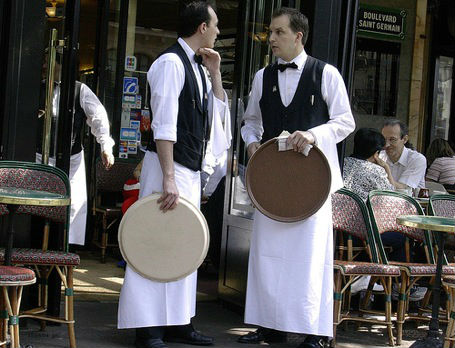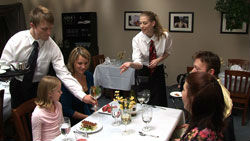1. DA’ SOLO – Ancona, Italy

Italian Chef Giuseppe Ciabolongo’s remote one-seat restaurant, nestled away in the hills of the Marché, has the distinction of being this year’s top restaurant. Reservations must be made ten years in advance since Da’ Solo only serves one guest per night—a solitary feast which often lasts over fifteen hours. Eager gastrophiles must be patient since the restaurant is only open four days a year, on the Summer and Winter Solstice and the Vernal and Autumnal Equinox.
2. TWIG & BERRIES – London, England

Native Londoner Mildred Cooms serves a menu of exclusively animal genitalia and reproductive organs at her trendy London gastropub. The uterine design of the dining room soothes guests with a womb-like comfort as they dig into Chef Cooms’ signature Spit-Roasted Duck Testicles with Cod Sperm Béarnaise.
3. FIELD OF DREAMS – Fargo, USA

The Farm-to-Table movement gets turned upside down at this rustic eatery in the middle of a soybean field in rural North Dakota. Former New York Chef Arlen Meecham tests his culinary skill by importing genetically-modified hothouse produce and factory-raised meats presenting them in a beautiful pastoral setting designed to trick locavores into thinking they’re eating organically.
4. BISTRO DERRIÈRE – Marseille, France

Guests at Jean-Pierre Lispenard’s neo-French bistro eschew forks and knives enjoying a multi-course tasting menu delivered rectally. Lispenard relies heavily on molecular gastronomy to distill complex flavors into suppositories which are administered to his guests by a staff of registered nurses. The talented sommeliers can also pair wines with retro-fitted bidets beneath the banquettes that bathe your undercarriage with a focused selection of biodynamic wines.
5. SPENDERÖRGAN – Frankfürt, Germany

As a young medical student German Chef Johannes Guttmann began preparing meals of human offal for classmates by smuggling organs from dissected cadavers from the university morgue. His obsession gradually took the shape of this exciting new pop-up restaurant in Frankfürt where visitors receive a medical examination upon arrival before each one agrees to contribute a vital organ to the evening’s meal.
6. KAISEKI SEBUN – Hokkaido, Japan

Chef Kumiko Nakarata started cooking professionally at six months old when, as an infant prodigy, she was invited to stage at Le Bernardin in New York City. Having just turned seven (Sebun is the Japanese character that represents her age), Ms. Nakarata is the youngest chef to appear on this list by over twenty years. Her restaurant—set along the Pacific Ocean in Hokkaido, Japan—is a destination for seafood lovers all over the world and tourists who come to see the youngest three-Michelin starred chef in history. Sebun changes its name to a new number every year to commemorate Kumiko’s birthday.
7. LEFTŒUVERS – Oslo, Norway

Meals begin at “Freegan” Chef Lars Jørgensen’s Scandinavian eatery in Oslo with each table foraging their own ingredients from a nearby landfill. Aside from turning food waste into haute cuisine, the restaurant was designed to be entirely self-sustaining, running all of its electricity on biofuels and kitchen grease. Trash from your meal is discarded directly into the landfill every night to be scavenged by tomorrow’s hungry gastronomes.
8. INADEMEN – Amsterdam, Netherlands

Dutch for “inhale,” diners need only breathe to enjoy each course of their prix fixe at this über-modern space designed by the husband and wife team of astro-physicists turned chefs, Sven and Hälle Nillstrom. At the communal table, your food is delivered in the form of flavored vapors you inhale through e-cigarettes. After toking your main course, you’ll be invited to the Nillstrom’s psychedelic hash bar next door for “dessert.”
9. CORO – São Paolo, Brazil

A team of 75 classically-trained Brazilian chefs prepare your meal in a kitchen the size of a soccer field. Unlike most professional kitchens, the chefs don’t work together. Each individually prepares one of your 75 different courses then the chefs—also classically-trained musicians—gather to invite you into the kitchen for a choral concert of epic proportions.
10. MUDPIE – Mexico City, Mexico

Chef Luisa Romero Ballatín-Cortez extols the health virtues of cooking with mud in her new restaurant on the outskirts of Mexico City. Chef Ballatín-Cortez spares no expense importing the finest mud from all over the world as far as the Himalayas and encorporates it into her unique Jaliscan-style cuisine. Diners come from near and far to experience such delicacies as Sri Lankan Mud-braised Wild Boar Enchiladas and her famous Oaxacan Red Mud Mole.
11. EMBRYŌ – Bangkok, Thailand
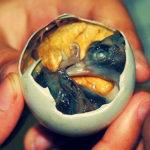
Animal fetuses and underdeveloped life forms are the specialty here at this subterranean restaurant in the seedy Soi Cowboy district of Bangkok. Four-hundred pound Chef Alex “Big Baby” Sriphatkorn built his own hatchery adjacent to the restaurant in order to harvest unborn animals he can cook immediately in his natural wood-fired ovens. Although “Big Baby” has become an international celebrity—most notably for his food-themed viral rap videos—look out for PETA activists who frequently protest outside the restaurant.
12. 171℃ – Bogotá, Colombia

Instead of preparing the food sous vide, Chef Simón Mascherano prepares his guests sous vide by mummifying them in plastic wrap and submerging them into temperature-controlled water baths. His technique ensures that none of his precious flavors can escape through the diner’s pores during the meal. He literally seals in your juices. After a highly published drowning case, Chef Mascherano moved his restaurant from Medellín to Bogotá where the higher altitudes allow his water baths to boil more gently at the perfect temperature of 171 degrees Celsius.
13. X/Y – San Francisco, USA

Have you ever stopped to consider the sex of the plant, animal or marine life you are eating? Most diners don’t, but Chef Angela Marx takes the matter very seriously at this San Fransisco eatery. She allows her guests to choose the gender of their steaks, chops, lobsters and even certain plant life. Try the “Girl’s Nite Out” ten-course tasting to experience Chef Marx’s menu of all female life forms. Sommelier Margueritte Thiebault takes special care to make sure the all-female winemakers wine pairings are seamlessly tailored to the menu’s feminine food.
14. FOCI – Various Undisclosed Locations

Created in 2048 in conjunction with Google Ventures, FOCI began as a Kickstarter project of Chef Kosmo3, a computer hacker with no formal culinary training. His futuristic kitchen brings the virtual reality experience to fine dining where diners consume a luxurious multi-media tasting menu without actually eating anything. Real-time biofeedback that reaches the kitchen’s “servers” through your Bluetooth-enabled cutlery allows the virtual chef to feed you images of what the body craves without the need for opinionated waitstaff.
15. CHEF:BÔT – Osaka, Japan

Adventurous diners can experience chef-less dining in Osaka, Japan where human cooks are replaced by 3D printers that prepare your meal tableside. Choose from a digital menu of iconic dishes made famous throughout the history of modern cooking. The restaurant’s patented Transparent Kitchen™ can create exact replicas of virtually any haute cuisine. It gives a new meaning to the concept of open kitchens.
16. THE MILLENNIAL KITCHEN – Napa Valley, USA
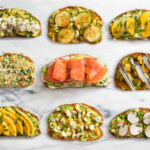
After a forty year hiatus from cooking, legendary Napa Valley Chef and pioneering locavore Alphonse Treadwell revives the comfort food that made him famous in the Oughts. His humble kitchen specializes in his once trendy but now retro dishes that have fallen out of favor like Avocado Toast, Pork Buns, Korean Fried Chicken and Cacio e Pepe.
17. LILY AND SAND – Dubai, UAE

It took over fifteen years to construct this giant 300,000 square foot flotilla in Dubai that seats over 5,000 guests at once making it the largest free-standing restaurant in the world. Guests must take a helicopter and three different ferries before arriving in the luxurious dining hall designed by architect I.M. Pei’s goddaughter. English Chef phenom Ian Chatterton’s Persian menu focuses on aquatic life and includes the most expensive dish in the world—a spit-roasted dolphin encrusted in 24-Karat Gold, yours for only $40,000.
18. DINE X – Outer Space

Billed as the first intergalactic culinary experience, Space X and Elon Musk have joined forces with the Culinary Institute of America to launch fine dining out of the Earth’s atmosphere. Patrons are rocket blasted into orbit for three hours where they can enjoy an intimate meal in a custom-made Space X dining capsule. Lay back in your Kevlar suit while you enjoy delicate space-raised meats barbecued over sizzling hot moon rocks and freeze dried desserts, both specialties of former NASA-engineer-turned-Astro-Chef Zoltan Janucyzk’s aeronautical kitchen.
19. GUSTIBUS – Philadelphia, USA
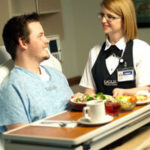
Visitors must check into the Dining Pavilion adjacent to the University of Pennsylvania Hospital at their scheduled reservation time. After receiving an epidural, a highly-skilled medical staff inserts small arthroscopic cameras into the guest’s digestive tract so he can joyfully witness his meal being digested in real time. The cafeteria-inspired menu was developed by a team of nutritionists at U. Penn—featuring such Heartland delicacies as Grass-Fed Salisbury Steak and Lancaster County Mushy Peas. Each diner is issued a secure portal to live-stream the camera feed from inside their stomach via Snapchat.
20. FORECLOSURE – Cayman Islands

Restaurant patrons must sign over the deeds to their homes to be invited to dine at this palace of modern cuisine in the Cayman Islands. Offshore accounting allows visitors to exploit tax shelters to offset their loss in personal wealth. In the spirit of the meal, the dining room is filled with repossessed furniture purchased by the restaurant from IRS auctions.
*Note: This list is fictional and purely for satirical purposes. Any similarities with real life restaurants, restauranteurs or chefs are purely coincidental. Maybe.


